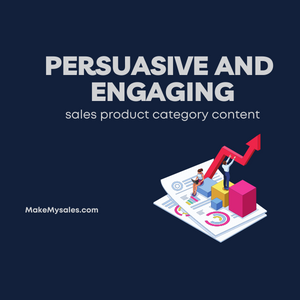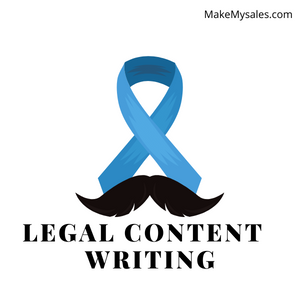Persuasive And Engaging Sales Product Category Content
- So if you’re looking for high quality sales copy
The goal of any sales message is the following: to persuade your prospects to take a desired action. Usually, this action will be to purchase a product or service. However, the same principles necessary for persuasive sales copy can be applied to any type of promotional content – whether that’s a blog or social media post, video, podcast or sales page.
How do you write in such a way that you alleviate the fears of your prospects, sufficiently explain what you have to offer, and then move them toward a purchase?
Here are some tips on how to craft an effective sales message that respectfully convinces, allays fears and ultimately, converts.
1. Evaluate the situation from your prospects’ point of view.
The foundation of any good sales message is a solid understanding of the interests, desires and needs of your prospects. Before you can even begin writing your sales message, it’s a good idea to visualize the thoughts and emotions they’ll be experiencing as they approach your content. You’ll also want to consider exactly who will be reading it.
Some questions to ask include:
- Who is my target market for this product or service? Take some time to construct a buyer persona.
- How did they find me?
- What’s the key problem or situation that led them to seek a solution? (i.e. What’s motivating them to find a solution?)
- What objections or concerns might they have about my product?
- What other products may they also be considering?
You’ll notice that all of these questions are related to your prospects. At this stage, your goals and needs are irrelevant; it’s all about the customer. Be sure to approach your writing with these needs and pain points in mind to craft the most engaging and effective copy possible.
2. Emotion is the key to drawing them in
Once you’ve gotten yourself into the mindset of your target market, you’ll likely notice a dominant emotion rising to the surface. While not all problems trigger intense emotions, all will have an emotional component (even if only a small one).
Here’s an example: When writing sales copy for a fire alarm, the temptation may be to focus on the unique features of the product. Perhaps it holds its battery power for longer than its competitors, or maybe it has received awards for its unique design. But let’s face it: Fire alarms aren’t sexy, and no amount of copy is going to change that.
What a smart sales message can do, however, is address the underlying emotions surrounding the sale. Rather than focusing on the features of the product – or even the benefits – we can discuss how our product addresses the emotional situation connected to it. In the example of the fire alarm, we could talk about how a more reliable alarm means greater safety and security for your family. The potential for a house fire is terrifying; and while we don’t necessarily want to use an outright fear appeal (i.e. arousing fear), our copy should help allay fears customers may already be experiencing.
3. Reason should follow
It’s only after an emotional appeal has been made that it’s time to address reason. Reason refers to the rational thoughts and ideas related to your product; in other words, the relevant facts and features, as well as any objections your readers may have.
Some elements you might want to include are:
- The size, capacity, color, etc. of your product. Basically, the features of your product.
- Your unique value proposition: How your product is different/better than the competition?
- Delivery details: How will the product be shipped or delivered, how much will this cost, etc.
- Objections: What thoughts may be preventing prospects from buying your product? Address these concerns head-on.
- Benefits: What are the practical and tangible benefits to using your product? What problems does it help solve?
Reason basically consists of all the informational and logistical aspects of your product and of the impending sale. It will also help to alleviate any practical concerns your readers may have by addressing common objections.
4. Credibility and social proof drive home the sale
Credibility is a subset of reason, however it can also help make an emotional connection with the reader by reducing the sense of risk. The goal is to allay the fears of your readers by showing that your product actually works and that others have benefited from it in the past.
- Customer or client testimonials or endorsements: e.g. “This product helped me reduce my expenses by 40%’
- Relevant statistics or research from credible sources: e.g. “The American Medical Association recommends using this type of product.” Link to the source whenever possible.
- Reference the popularity of a product: e.g. “1,000 business owners have already signed up for this program.”
- Past results (self-proclaimed): e.g. “We have already had over 50 clients achieve million dollar results with our service.” Show proof of these results whenever possible.
- Customer reviews or ratings: A plugin like WP Review Bank can help with this.
4 bonus tips for effective sales copy
The 4 elements above will give you a good start at crafting an effective sales message. Here are a few bonus tips that will help you take your copy a step further.
- Avoid relying on hype: Overstating benefits or making wild, unsubstantiated claims about your product can work in the short term; however they can also be a serious turn off to your more perceptive customers. Truth-telling and copywriting aren’t mutually exclusive. Marcia Yudkin’s book No-Hype Copywriting: The Keys to Lively, Appealing and Truthful Sales Writing is a great primer on truthful yet persuasive writing techniques.
- Use conversational language: Your sales copy is not the place to try to impress your readers. Use language that’s familiar and comfortable to your prospects (i.e. Avoid “industry speak”), and use a casual, personal tone/voice. In other words, write like you talk – even if that breaks some basic rules of grammar. It’s better to come across as approachable and trustworthy than to write the “perfect” copy.
- Test out long copy and short copy: There’s quite a debate over which is more effective. The truth is, they can each work well, depending on the niche, business and audience. In their Definitive Guide to Copywriting, person x and Person y do an excellent job of outlining the pros and cons of each.
- Utilize storytelling: It’s a good idea to open your sales copy by sharing a personal story or anecdote to signal to your readers that you understand where they’re coming from. A story functions as a great hook, drawing the reader in to the rest of the copy.
Conclusion
I think we often get hung up on following someone else’s “proven” copywriting template or framework. While the elements above work effectively for me and many others, there is no one-size-fits-all strategy for writing persuasive copy.
Keep in mind that what works in one niche may not work in another, so it’s important to test out a variety of copywriting strategies. The strategies above are a great starting point, but use them flexibly to create copy that’s right for your audience.
What strategies or elements do you use for creating persuasive sales content marketing copy? Any examples you can share?







Sheela Ramesh –
Best Persuasive And Engaging Sales Product Category Content